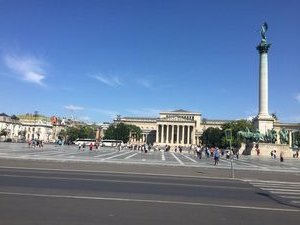Advertisement
Published: July 10th 2015

 Heroes' Square
Heroes' Square
On the Pest Side. Built for the 1896 celebration. Includes the tomb of the unknown soldier. It was not until 1873 that the three cities of Buda, Pest and Obuda were united to create the international hub that is known as Budapest. Elena, our guide, told us that even today native inhabitants of either side of the river would never dream of deserting the one side for the other.
This morning we embarked on a whirlwind tour of Buda and Pest with a small group and a guide. We heard about the history of the city from its early mythic pre-Christian origins until today. We drove on Andrassy Avenue, also known as Budapest's Champs Elysees, built up in anticipation of the 1896 exposition celebrating 1000 years since the founding of Hungary (yes, 1896), viewed the walls outside of the Buda part of the city that had been constructed in the Middle Ages, partially destroyed during World War Two, and then reconstructed, and stood at the site of the ancient fish market overlooking the Danube from on high.
One of my favorite parts of the trip was when we departed from the group to go into a local Prima supermarket where I got to take pictures of the merchandise and my father checked out the cookie

 Pest Side from the Hotel Roof
Pest Side from the Hotel Roof
Wide avenues and boulevards and stately architecture of the late 19th century. and chocolate aisle (see photos).
All this richness can be intoxicating. Budapest is a cosmopolitan center that at the start of a new century is once again drawing elites and immigrants from all over the world. But its success masks more troubling realities: almost 50% of the Hungarian population lives under the poverty line. An extreme nationalist right wing Hungarian government is openly anti-immigrant and anti-Semitic. I feel extremely privileged to enjoy the bounty of the city. And in this era of increasing vulnerability for most of the world's population I wonder what the taxi and bus drivers who don't speak English think of the well-off tourists who flock into the city from all corners of the globe and then head off while they still struggle to make ends meet on the Hungarian florint currency (1000 florints equals about 4 U.S. dollars).
In a short while we will head over to the Jewish quarter to tour and to attend a Shabbat service this evening in the second largest synagogue in the world. More to come after Shabbat about Judapest.
Shabbat Shalom!
Advertisement
Tot: 0.257s; Tpl: 0.019s; cc: 6; qc: 44; dbt: 0.1799s; 1; m:domysql w:travelblog (10.17.0.13); sld: 1;
; mem: 1.1mb

 Heroes' Square
Heroes' Square
 Pest Side from the Hotel Roof
Pest Side from the Hotel Roof



















Ellen
non-member comment
Fascinating
Sounds like an interesting place to spend some time. Looking forward to hearing more about your Shabbat experience.